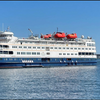National Workboat Association: CTV Safety Improved
The safety statistics released by the National Workboat Association (NWA) demonstrate progressive improvement in the Crew Transfer Vessels (CTVs) safety performance of workboat crews and operators, with a considerable drop in the rate of incidents between 2014 and 2017.
This four-year statistical summary has been compiled using annual accident data submitted by the NWA’s membership of workboat owners and operators, working in a range of maritime sectors including offshore wind, towage, aquaculture and construction support.
Given the critical role vessel support plays across many maritime industries, crews and operators in the expanding workboat sector face a number of common challenges, including long hours of operation in testing environmental conditions, and pressure to meet deadlines for logistically demanding projects.
In this context, crew fatigue has been identified as a potential contributor to incidents during operation, while the industry has also placed considerable emphasis on ensuring access to robust safety training and best practice guidance.
These efforts appear to be having a positive impact on overall safety, with the statistics revealing gradual improvement across all workboat categories. Amongst surveyed NWA members, the total number of recordable incidents including medical treatments and lost time injuries (LTIs) has been reduced by 38% across the 4 years, with no fatalities reported in the past two years.
The Total Recorded Incident Rate (TRIR), which takes into account the number of hours worked, fell from 5.8 in 2014 to 1.07 in 2017.
Within offshore wind specifically, while there has been much industry debate over the safety of traditional turbine access methods, no incidents involving technician transfers were reported by NWA members during the four-year data collection period. This provides strong evidence that Crew Transfer Vessels (CTVs) do offer a safe method of transfer to wind turbines, especially when carried out by competent, trained crew and technicians.
Across the full membership, incidents involving slips, trips and falls have consistently remained the single largest reported cause of injury aboard workboats – constituting around 40% of total incidents on average each year, ahead of incidents involving equipment (13% on average) and manual handling (12% on average).
Major incidents involving critical injury or fatality have thankfully remained a rare occurrence, as the industry has continued to focus on training and operational planning for complex operations.
NWA Secretary, Mark Ranson, said: “While the incident rate has fallen significantly in recent years, it is clear that, as a sector, there is still considerable room for improvement. Our next target has to be to reduce the total recorded incident rate (TRIR) to less than 1.0 as we strive to emulate the safety performance of other sectors.”
“This will be achieved, not only via ongoing efforts in safety training, debate and guidance, but also by establishing a culture of thorough and transparent HSE reporting for workboat crews and operators across all maritime industries. Currently, reporting rates stand at just under 50% - but as we increase this figure, we will also improve the efficacy of these statistics as a tool for pinpointing and addressing key risks to crew safety.”
The 2014-2017 Safety Statistics were first announced at the NWA’s October 2018 Safety Forum, a regular meeting that brings together workboat operators from all sectors for open and transparent discussion of the main quality, health, safety, security and environmental issues affecting the operation of workboats.
2018 has also seen the launch of safety and training initiatives including the NWA Towage Good Practice Guide, the Workboat Crewmember Apprenticeship and the ‘Understanding Fatigue’ poster campaign.








